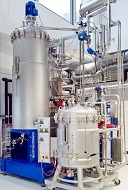
To date, residual material from the food processing industry is exploited as a feed additive or as an energy source since its use as feedstock for the production of chemicals is still technically and economically challenging. One example is extracted sugar beet press pulp. The pulp consists of various sugar polymers (pectin, cellulose, hemicellulose).
Preliminary work already showed the possibility of releasing D‑galacturonic acid from sugar beet press pulp through the use of pectinases secreted by the fungus Aspergillus niger. In the subsequent step, the released acid was converted almost entirely to L‑galactonate with recombinant Saccharomyces cerevisiae. (1) (2)
Further research aims to increase the added value of pectin-containing agricultural residues. One approach is the additional use of the contained hemicellulose via enzymatic conversion to pentoses, which can be used for further biotransformation with Aspergillus niger. Another procedure is to use L-galactonate with recombinant yeasts to convert it into higher-value products.
Subject of this research project will be the reaction and process engineering analysis for the efficient hydrolysis of extracted sugar beet press pulp with integrated whole-cell biocatalysis. Project partners are carrying out the genetic work to provide the improved Aspergillus niger and Saccharomyces cerevisiae strains.
These studies are part of the collaborative research project PRO-SUPER (coordinator Prof. Philip Benz, Professorship of Fungal Biotechnology in Wood Science, TUM), financed by the Federal Ministry of Education and Research, Germany.
Publications
- Regmi P, Knesebeck M, Boles E, Weuster-Botz D, Oreb M (2024): A comparative analysis of NADPH supply strategies in Saccharomyces cerevisiae: Production of D-xylitol from D-xylose as a case study. Metab Eng Comm 19: e00245.
- Knesebeck M, Schäfer D, Schmitz K, Rüllke M, Benz JP, Weuster-Botz D (2023): Enzymatic one-pot hydrolysis of extracted sugar beet press pulp after solid-state fermentation with an engineered Aspergillus niger strain. Fermentation 9: 582.